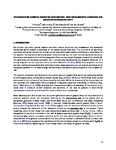Modelling the alongshore variability of optimum rip current escape strategies on a multiple rip-channelled beach
| dc.contributor.author | Castelle, B | |
| dc.contributor.author | McCarroll, Jak | |
| dc.contributor.author | Brander, RW | |
| dc.contributor.author | Scott, Tim | |
| dc.contributor.author | Dubarbier, B | |
| dc.date.accessioned | 2016-03-29T10:27:47Z | |
| dc.date.issued | 2016-01-01 | |
| dc.identifier.issn | 0921-030X | |
| dc.identifier.issn | 1573-0840 | |
| dc.identifier.uri | http://hdl.handle.net/10026.1/4433 | |
| dc.description.abstract |
Rip currents are a leading cause of drowning on beaches worldwide. How bathers caught in a rip current should attempt to escape has been a subject of recent debate. A numerical model of human bathers escaping from a rip current flow field is applied to a 2-km-long section of the open beach of Biscarrosse, SW France. The study area comprises 4 rip channels that visually appear similar from the beach, but exhibit different morphologies. Simulations are run for 2 representative hazardous summer wave conditions. Results show that small changes in the bar/rip morphology have a large impact on the rip flow field, and in turn on the alongshore variability of the optimal rip current escape strategy. The overall flow regime (dominant surf-zone exits versus dominant recirculation), which is found to be influenced by the alongshore dimensions of the sand bars adjacent to the rip channel, is more important to rip current escape strategy than rip velocity. Flow regime was found to dictate the success of the “stay afloat” strategy, with greater success for recirculating flow. By comparison, the dominant longshore feeder current and rip-neck orientation determined the best direction to “swim parallel” towards. For obliquely incident waves, “swim parallel” downdrift then swim onshore with breaking waves was highly successful and can become a simple safety message for beach safety practitioners to communicate to the general public. However, in SW France where rip spacing is large (∼400 m), surf-zone eddies have large spatial scales of the order of 100+ m, requiring a large distance (100+ m) to swim to reach safety, therefore requiring good swimming ability. This also shows that in addition to rip current intensity, rip flow regime and the depth of adjacent sand bars, rip spacing is important for defining rip current hazard and the best safety message. Our results also indicate that for normal to near-normal wave incidence, rip current hazard and best rip current escape strategy are highly variable alongshore due to subtle differences in bar/rip morphology from one rip system to another. These findings challenge the objective of developing a universal rip current escape strategy message on open rip-channelled beaches exposed to normal to near-normal wave incidence, even for seemingly similar rip channels. | |
| dc.format.extent | 663-686 | |
| dc.language | en | |
| dc.language.iso | en | |
| dc.publisher | Springer Science and Business Media LLC | |
| dc.subject | Rip current | |
| dc.subject | Beach safety | |
| dc.subject | Escape strategy | |
| dc.subject | Alongshore variability | |
| dc.subject | Rip channel morphology | |
| dc.subject | Rip flow regime | |
| dc.title | Modelling the alongshore variability of optimum rip current escape strategies on a multiple rip-channelled beach | |
| dc.type | journal-article | |
| dc.type | Article | |
| plymouth.author-url | http://gateway.webofknowledge.com/gateway/Gateway.cgi?GWVersion=2&SrcApp=PARTNER_APP&SrcAuth=LinksAMR&KeyUT=WOS:000370068400032&DestLinkType=FullRecord&DestApp=ALL_WOS&UsrCustomerID=11bb513d99f797142bcfeffcc58ea008 | |
| plymouth.issue | 1 | |
| plymouth.volume | 81 | |
| plymouth.publication-status | Published | |
| plymouth.journal | NATURAL HAZARDS | |
| dc.identifier.doi | 10.1007/s11069-015-2101-3 | |
| plymouth.organisational-group | /Plymouth | |
| plymouth.organisational-group | /Plymouth/Faculty of Science and Engineering | |
| plymouth.organisational-group | /Plymouth/Faculty of Science and Engineering/School of Biological and Marine Sciences | |
| plymouth.organisational-group | /Plymouth/REF 2021 Researchers by UoA | |
| plymouth.organisational-group | /Plymouth/REF 2021 Researchers by UoA/UoA07 Earth Systems and Environmental Sciences | |
| plymouth.organisational-group | /Plymouth/Users by role | |
| plymouth.organisational-group | /Plymouth/Users by role/Academics | |
| dcterms.dateAccepted | 2015-09-29 | |
| dc.rights.embargodate | 2018-1-1 | |
| dc.identifier.eissn | 1573-0840 | |
| dc.rights.embargoperiod | 24 months | |
| rioxxterms.versionofrecord | 10.1007/s11069-015-2101-3 | |
| rioxxterms.licenseref.uri | http://www.rioxx.net/licenses/under-embargo-all-rights-reserved | |
| rioxxterms.licenseref.startdate | 2016-01-01 | |
| rioxxterms.type | Journal Article/Review |


